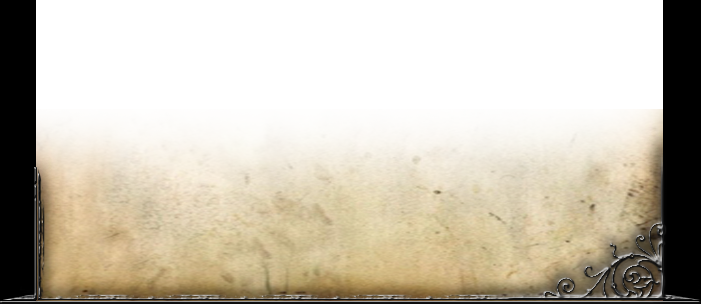Standard
Eyes
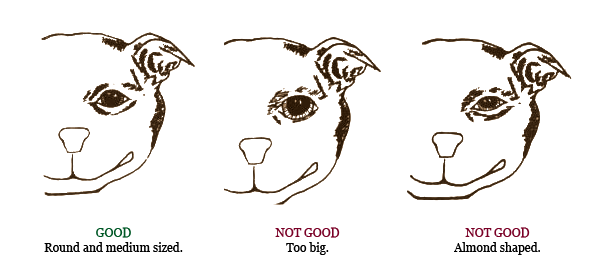

Head and Skull
The head must be short with a constantly deep wide skull and plastically bulging jaw muscles, bulging stop short cannies and black nose. The Staffordshire Bull Terrier belongs to those breed of which the most important body part is the head. In other words it is a "head breed". This head must show a strict beauty with wide, short cannies which shows strenght and personality. These are the battle-signs of a Staffordhire. Strong muscles link the head together which gives high biting power and a scissor-like shape. According to most of the breeders and judges the ideal differene between the head and the nose is 2:1. The nostrils should always be big and black. The meat coloured nose with pigment problems means exclusion from breeding. The head of the bitches should be fenomenal and should never be mixable with butches. The bitches that resemble butches are giving their bad genes to their puppies and a butchy bitch head always has handicap. The Stafford sign below the eye should be filled completely so that the cannies could develop just fine. The lower jaw should be wide from the front and should show strenght. It can never be narrow and back beating. These dogs should never be dishface or downface. These faults are strongly avoidable.
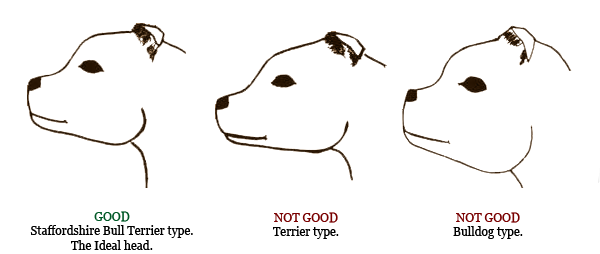

Ears
The ear position is very important with Staffordshire Bull Terriers overal. If the ears are too big (flying ears) or too tall it can mean a big problem. The ideal ears should be little, thin and delicate but most of all they should be rose-shaped. The ears should be closed to the outside when excited like a half-standing ear, but these kind of ears very rarely lead to good face and skullshape. So this other kind of ear is half-standing and should be narrow which looks very good. But too heavy or too big ears make Dumbo-effect and destroy the whole effect of the dog. In the old days most pit-ears were like Staffordshire Bull Terrier ears, they cut their ears. It is good that today, animal rights ban this. With fully standing ears the dog looks like a bat. I can only remember one dog to win with these kind of ears in the 1970s (Ch. Ellasteve Bella), a bitch that has been to many exhibitions until she could win that title.
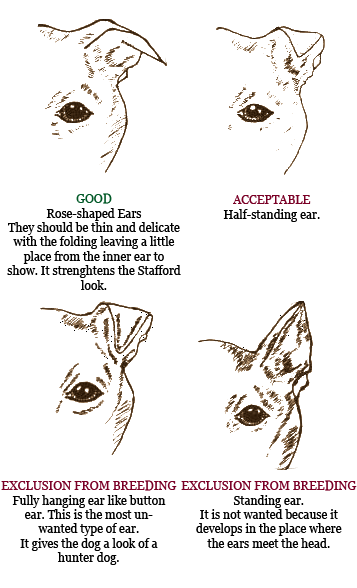

Bite and Jaw position
Probably this is the most discussed problem with this kind and there are always hours of arguements about the Stafford bite. The standard requires scissor-bite (the upper teeth closes tightly to the lower) and the huge teeth and the tight lips. A strongly deep or high bite should be punished. If the cannies are too short the dog can bite too frontally especially when it becomes older when the jaw becomes stronger. This short cannie simply brings non-ideal little teeth. It is fortunate that this kind of skull is very rare thatnks to the well-thought breeding program. Also thanks to this the hard type of bulldog heads and a very short teeth is nearly gone. The lack of P1 in teeth is acceptable but any other miss means exclusion of breeding.
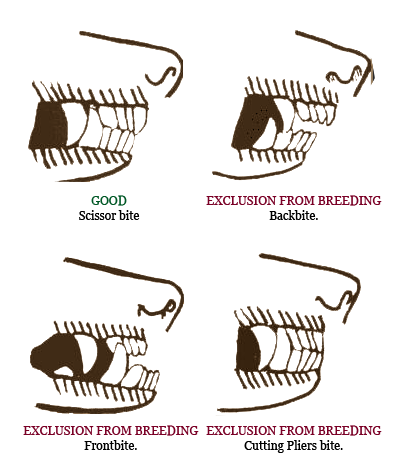

Forelimbs
The front legs should be straight and strong boned, fairly widely next to each other. They should not be confused with a bulldog, the feet are much more below the dog, and the bones are strong, confident, without any faults. With the front legs there may be a little weakness in the feet and also in the area of the paws. The feet should be facing the outside a little. The shoulders are well laid-back, while it should be understood that the blade makes an angle of about 45 degrees. The shoulder may not be steep. Some believe the judges favor the very short neck, but a very short neck and shoulders exclude each other. The well-shaped shoulders affect the connectivity of the neck, the neck is the connecting to the back smoothly. The neck can not be stuck on because the dog's neck in such a shoulder construction may be defective. The neck is accompanied by a light curve and ends in the body. If the dog's shoulder is loose, it can be a said that it has a good flow of movement. Far out it can go and beat a good move. The steep shoulders exclude a short stalk movement like that Foxterriers'. The Staffordshire Bull Terrier in his own sportive, athletic is famous for its properties and would be a terrible with a Foxterrier-like movement.


The Body
The body begins with the rib basket, and lasts to the groin. The breasts, elbows should be tight and wide. The important feature of the dog is good physical condition. Not like the dog that is under development, or moves too little. It can be recognized, such as in a competition, that the dog "must be prepared". By this the judge understands that with age the dog may be even better and its movement can become better. The judges require a tight, straight and upline rib. Special judges also say that a light muscular arch over the loin, is not wanted. That's can be a strong fault of the breeding. People are very easy to recognize this because the arch of the back can be seen above the height of the loin. The part after the front can not be sunk. The Stafford is a powerful, compact dog, so it needs a strong back. In no way it is desirable to have a descent back to the middle of the crsossbone, and the back should not fall at the rear either. In the pubic area it is necessary that the dog can move about freely, the short bond at the ribs to the tigh. With the males, exclusion from breed can also be the hidden testicles and half-testicles.
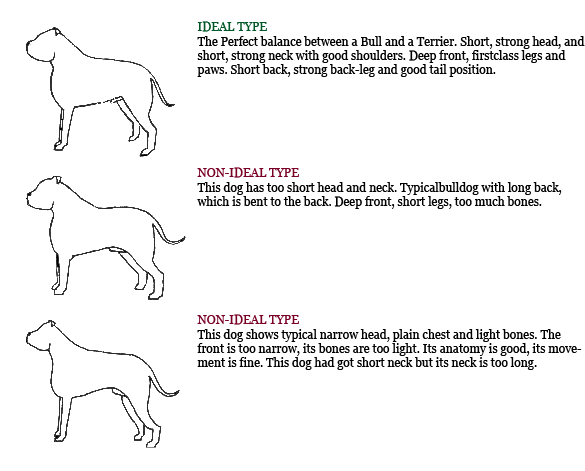

Hind legs
The Staffordshire Bull Terrier has got strong, well-muscled rear legs with deep ankles and good angles. Seen from behind, the legs should be completely parallel. A good and well angled strong hind leg is very important. Only this combination gives the dog the boost which makes it so well-known. Without this boost, the dog would not be in a good position in a fight, for it could not move well in the ring. The rear legs also need power, this allows the dogs' impact to the enemy. In addition, without well-structured, long muscles, the Stafford should never have been in position and could not have achieved the task in the Pit.
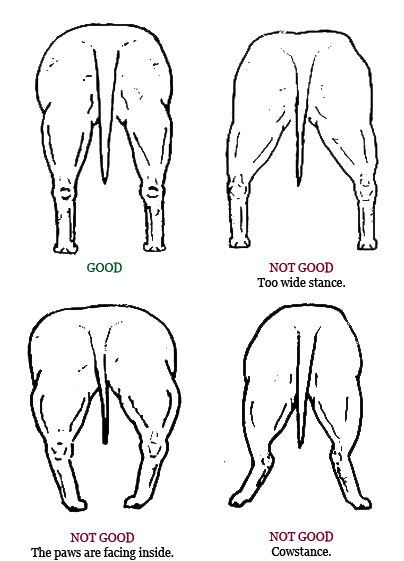

Paws
The paws should be strong and medium-sized with well-cushioned pads. A Staffordnakcan not have a bony catpaw. A tight paw, which is out at the middle easily to the first leg is desired. This property is particularly important in the boost of the feet. The man can compare this to the finest sprinters feet. The startedge moves from one side to the other. This helps the dog to increase the speed and it develops of good posture. The old breeders have enabled their battle dogs to this movement. They linked this to the breeding of the animals, because they knew that the Pit was just a short distance to overcome, but it must have been done quickly. Today, this seems too theoretical but in the old days it was necessary, because the stakes of winning or losing depended on a small advantage. The ideal paw was a semi-stretched one with big spaces between the toes, and the cams were just slightly outward. The paws were not balancing paws or completely rabbit-like paws, because they meant a big mistake, for they dramatically affected the dog's movement. Such a dog in the pit would have been unfit to carry out its tasks.


Tail
The best is the medium tail, starting with deep, narrow which is carried low. The tail should not show strong curvature like in the past, when the curvature of a dog's tail was mostly like the handle of a well. The tail is like the oar, the steering wheel, which is always helps the dog balancing itself in a fight. When in a fight it isin the back and constantly moving from side to side. The tail is strong, the pointy end should be sharp. When the dog is excited it is still not allowed to have the topline over the level of the back. However, it is important that the tail should reach the rear leg. If the dog's tail is too short it ruins its balance. The old breeders did not like the long tail, because it was believed that the long-tailed dogs, were often cowards. If there is a corkscrew-like tail, the dog's conformation is certainly Bull. I remember one such dog CH. Spotty Lady from 1970, whose owner was Charlie Whiteworth.
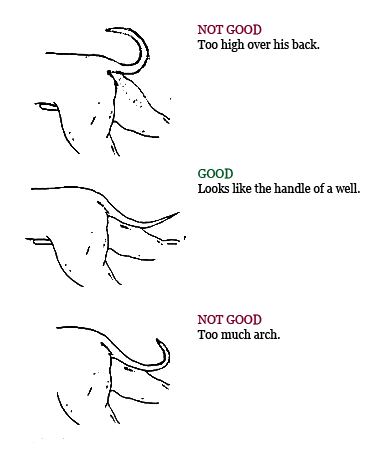

Motion
The movement should be seen as free and strong. The front and rear legs are moving parallel with absolute visible-thrust power on the rear legs. We understand Motionflow as a method on which a certain mode the dog's muscles move when it walks. The Stafford moving stlye is when the front feet turning neither in nor out, but the rear legs move in parallel with the front ones. The motion must be neither too tight nor too wide, it should be placetaking. A Staffordnak with good movement of the shoulders and good rear legs, corresponding angles will be worthwhile and gratifying. A Stafford with loose shoulders, and elbows facing the outside, and with steep shoulder arch outwards and over the corners of hock, is unable to produce such a powerful movement.
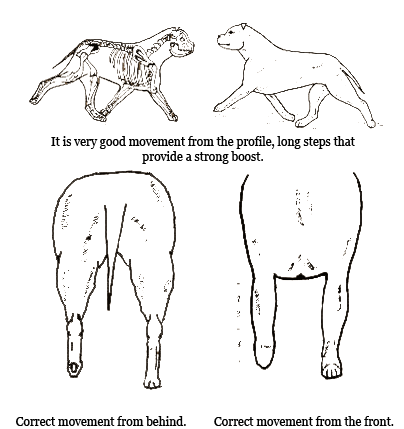

Fur
The Stafford smooth fur should be short and tight. When touched we should felt a comfortable grip with medium hardness. If the dog is excited, the muscles stretch, the hair is covering its body like a tight suit of armor. This will make the muscle movements visible. The hair of the dog shows whether it is in good condition. If yes, a nice smooth and shiny fur can be seen. The hair should not be rude, rough or long. This may indicate that the dog is kept in a cold and draughty place. Mostly home is a good growing and weightgaining place. This is shown in exhibition ring, where you can realize the difference in the kennel dogs and the dogs kept at home.

Color
The color of Staffordshire Bull Terrier is hotly contested. The color what we discuss most is the black and tan. The experts can not tell the difference between color black and tri-color. Briefly explained: the black-tan is two, while the tri-color is three colors. It's that simple. Stafford recognized colors are: red, pale, white, black or blue. While this is correct, these colors with white markings or spots are also acceptable. The black and mauve is not desirable. In the U.S. these dogs are excluded from exhibitions. The red dogs look good with a dark mask and claws. The referees should have the healthy human understanding to work, rather than be againts animals, because of the variety that offers a range of colors but they are not 100% correct. Always keep in mind that the color does not affect the effectiveness of the Stafford. I always heard that the blue color comes from Blue Paul. However, it is only here that it's in the the name of the dog, although there's no link in the blue color between Paul and the Blue Stafford. Genetically blue, fawn, black and speckled colors are related to each other, you should just look at other breeds, where the rulers of these colors appear: German Dog, Whippets, Greyhunds, Shar PEIS and some other. Each carries the blue color in the genes. And even the identity of the Bulldog can bring out such colors. If the colors would have a joint ancestor then it would be white, and the Bulldog is the number one candidate in that. As regards to the reasons for the rejection of the black it is mostly regarding the paws. The old Black on Tan terrier (the English Toy Terrier) has got longer claws on her finger than the rest, the rear feet were catlike. With Paws like this it had no sure grip on the floor in the Pit, because the dog had pushed himself forward. This handicap was the fact because of that the old breeders didn't like that color. Every black on tan dog I've seen black - regardless of the breeder - showed this characteristic. It means without doubt that they were the strengths of this type both in the color and the conformation. One of the public errors was always that the external claws and toes were shorter than the interior.

Size and Weight
The desirable weight for males is from 12.7 to 17.25 kilograms. Bitches from 10.9 to 15.4 kilograms. The withers height is 35.6 to 40.6 cm. The height and weight must be proportional. In previous years, the weight and a height was duscussed a lot. In the 1930s, it was not unusual for a Stafford to be 18 ft and 16 inches in height, on the other side is 19 inches tall, 50 lbs heavy. Today, there is greater height and weight balance within the breed. We always make consents, and these times always the best-balanced dog wins, even if it is a bit bigger or heavier than the standard values. The main purpose of today's breeders is to breed dogs that are especially typical. In any event, I hope I will soon see the last small, short legged, heavy-headed dog, such as that of the '60s and early '70s so often. In the standards there are the physical characteristics, which make our Staffords different and enable them to perform their duties, for which the breed was originally bred.


